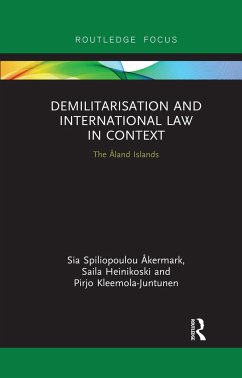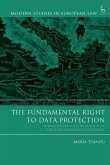Sia Åkermark, Saila Heinikoski, Pirjo Kleemola-Juntunen
Demilitarization and International Law in Context
The Åland Islands
Sia Åkermark, Saila Heinikoski, Pirjo Kleemola-Juntunen
Demilitarization and International Law in Context
The Åland Islands
- Broschiertes Buch
- Merkliste
- Auf die Merkliste
- Bewerten Bewerten
- Teilen
- Produkt teilen
- Produkterinnerung
- Produkterinnerung
The demilitarisation and neutralisation of the Åland Islands is a confirmation of, and an exception to, the collective security system in present-day international affairs. Its core idea is that there is no need for military presence in the territory of the islands and that they are to be kept out of military activities. Through parliamentary an
Andere Kunden interessierten sich auch für
![Private International Law and Competition Litigation in a Global Context Private International Law and Competition Litigation in a Global Context]() Mihail DanovPrivate International Law and Competition Litigation in a Global Context65,99 €
Mihail DanovPrivate International Law and Competition Litigation in a Global Context65,99 €![International Criminal Law in Context International Criminal Law in Context]() International Criminal Law in Context61,99 €
International Criminal Law in Context61,99 €![The Habitats Directive in its EU Environmental Law Context The Habitats Directive in its EU Environmental Law Context]() The Habitats Directive in its EU Environmental Law Context69,99 €
The Habitats Directive in its EU Environmental Law Context69,99 €![The Fundamental Right to Data Protection Normative Value in the Context of Counter-Terrorism Surveillance The Fundamental Right to Data Protection Normative Value in the Context of Counter-Terrorism Surveillance]() Maria TzanouThe Fundamental Right to Data Protection Normative Value in the Context of Counter-Terrorism Surveillance53,99 €
Maria TzanouThe Fundamental Right to Data Protection Normative Value in the Context of Counter-Terrorism Surveillance53,99 €![European Union Law in Context European Union Law in Context]() Ester Herlin-KarnellEuropean Union Law in Context42,99 €
Ester Herlin-KarnellEuropean Union Law in Context42,99 €![Law and Religion in Theoretical and Historical Context Law and Religion in Theoretical and Historical Context]() Law and Religion in Theoretical and Historical Context47,99 €
Law and Religion in Theoretical and Historical Context47,99 €![Cosmopolitanism in Context Cosmopolitanism in Context]() Cosmopolitanism in Context47,99 €
Cosmopolitanism in Context47,99 €-
-
-
The demilitarisation and neutralisation of the Åland Islands is a confirmation of, and an exception to, the collective security system in present-day international affairs. Its core idea is that there is no need for military presence in the territory of the islands and that they are to be kept out of military activities. Through parliamentary an
Produktdetails
- Produktdetails
- Verlag: Routledge
- Seitenzahl: 144
- Erscheinungstermin: 14. August 2020
- Englisch
- Abmessung: 216mm x 140mm x 8mm
- Gewicht: 191g
- ISBN-13: 9780367607081
- ISBN-10: 0367607085
- Artikelnr.: 66570896
- Herstellerkennzeichnung
- Libri GmbH
- Europaallee 1
- 36244 Bad Hersfeld
- gpsr@libri.de
- Verlag: Routledge
- Seitenzahl: 144
- Erscheinungstermin: 14. August 2020
- Englisch
- Abmessung: 216mm x 140mm x 8mm
- Gewicht: 191g
- ISBN-13: 9780367607081
- ISBN-10: 0367607085
- Artikelnr.: 66570896
- Herstellerkennzeichnung
- Libri GmbH
- Europaallee 1
- 36244 Bad Hersfeld
- gpsr@libri.de
Sia Spiliopoulou Åkermark, Jur. dr., Associate Professor (docent) in international law, Director, The Åland Islands Peace Institute (Finland). Her work focuses on diversity, autonomy, the use of force and international law and its institutions. Saila Heinikoski , Ph.D. (Political Science), M.A. (University of Turku, Finland). Her work focuses on the European Union, European and national foreign and security policies, mobility and political discourses. Pirjo Kleemola-Juntunen, LL.D., LL.Lic., LL.M., Postdoctoral Researcher, Northern Institute for Minority and Environmental Law/Artic Centre, University of Lapland. Her work focuses on international law in particular the law of the sea and international environmental law.
Foreword
Notes on Co-authors
Abbreviations
1 Introduction: The Goal and Structure of the Book
1.1 Early Occurrence of Demilitarisation
1.2 The Concept of Demilitarisation
1.3 The Birth and Impact of 'Comprehensive Security'
1.4 From the Cold War to a Multipolar World?
1.5 Militarisation Trends and Discourses Today
1.6 Geopolitics and Securitisation as Potential Justifications for
Militarisation
2 The Legal Regulation of the Demilitarisation and Neutralisation of the
Åland Islands
2.1 An Overview of the International Agreements Establishing the
Demilitarisation and Neutralisation of the Åland Islands
2.2 The 1921 Convention on the Non-Fortification and the Neutralisation of
the Åland Islands
2.3 The Åland Islands and Finland After the Second World War
2.4 Times of Challenge
2.5 Remarks on the Legal Validity of the Norms
3 The Law of the Sea and the Demilitarisation of Åland
3.1 Maritime Jurisdictional Zones
3.2 Navigational Rights
3.3 Navigational Rights in the Territorial Waters of the Åland Islands
4 Regional Security Co-operation and the Åland Islands
4.1 Finland, Åland and the European Union (EU)
4.2 Integration in the Baltic Sea Region and the Åland Islands
4.3 Bilateral and Nordic Co-operation: The Example of SUCBAS
4.4 Finland, Åland and the North Atlantic Treaty Organization (NATO)
4.5 The Åland Islands in Regional Security Co-operation as Understood in
Finland
4.6 Demilitarisation Between Regionalism and Multilateralism
5 Outlook and Conclusions
5.1 Peace Through Law?
5.2 The Concept of Sovereignty Reshaped
5.3 The Åland Islands Regime as Part of Contemporary Collective Security
5.4 Afterword: Does the Demilitarisation Add Anything to the Quest for
Peace in the Baltic Sea?
Appendix
Bibliography
Index
Notes on Co-authors
Abbreviations
1 Introduction: The Goal and Structure of the Book
1.1 Early Occurrence of Demilitarisation
1.2 The Concept of Demilitarisation
1.3 The Birth and Impact of 'Comprehensive Security'
1.4 From the Cold War to a Multipolar World?
1.5 Militarisation Trends and Discourses Today
1.6 Geopolitics and Securitisation as Potential Justifications for
Militarisation
2 The Legal Regulation of the Demilitarisation and Neutralisation of the
Åland Islands
2.1 An Overview of the International Agreements Establishing the
Demilitarisation and Neutralisation of the Åland Islands
2.2 The 1921 Convention on the Non-Fortification and the Neutralisation of
the Åland Islands
2.3 The Åland Islands and Finland After the Second World War
2.4 Times of Challenge
2.5 Remarks on the Legal Validity of the Norms
3 The Law of the Sea and the Demilitarisation of Åland
3.1 Maritime Jurisdictional Zones
3.2 Navigational Rights
3.3 Navigational Rights in the Territorial Waters of the Åland Islands
4 Regional Security Co-operation and the Åland Islands
4.1 Finland, Åland and the European Union (EU)
4.2 Integration in the Baltic Sea Region and the Åland Islands
4.3 Bilateral and Nordic Co-operation: The Example of SUCBAS
4.4 Finland, Åland and the North Atlantic Treaty Organization (NATO)
4.5 The Åland Islands in Regional Security Co-operation as Understood in
Finland
4.6 Demilitarisation Between Regionalism and Multilateralism
5 Outlook and Conclusions
5.1 Peace Through Law?
5.2 The Concept of Sovereignty Reshaped
5.3 The Åland Islands Regime as Part of Contemporary Collective Security
5.4 Afterword: Does the Demilitarisation Add Anything to the Quest for
Peace in the Baltic Sea?
Appendix
Bibliography
Index
Foreword
Notes on Co-authors
Abbreviations
1 Introduction: The Goal and Structure of the Book
1.1 Early Occurrence of Demilitarisation
1.2 The Concept of Demilitarisation
1.3 The Birth and Impact of 'Comprehensive Security'
1.4 From the Cold War to a Multipolar World?
1.5 Militarisation Trends and Discourses Today
1.6 Geopolitics and Securitisation as Potential Justifications for
Militarisation
2 The Legal Regulation of the Demilitarisation and Neutralisation of the
Åland Islands
2.1 An Overview of the International Agreements Establishing the
Demilitarisation and Neutralisation of the Åland Islands
2.2 The 1921 Convention on the Non-Fortification and the Neutralisation of
the Åland Islands
2.3 The Åland Islands and Finland After the Second World War
2.4 Times of Challenge
2.5 Remarks on the Legal Validity of the Norms
3 The Law of the Sea and the Demilitarisation of Åland
3.1 Maritime Jurisdictional Zones
3.2 Navigational Rights
3.3 Navigational Rights in the Territorial Waters of the Åland Islands
4 Regional Security Co-operation and the Åland Islands
4.1 Finland, Åland and the European Union (EU)
4.2 Integration in the Baltic Sea Region and the Åland Islands
4.3 Bilateral and Nordic Co-operation: The Example of SUCBAS
4.4 Finland, Åland and the North Atlantic Treaty Organization (NATO)
4.5 The Åland Islands in Regional Security Co-operation as Understood in
Finland
4.6 Demilitarisation Between Regionalism and Multilateralism
5 Outlook and Conclusions
5.1 Peace Through Law?
5.2 The Concept of Sovereignty Reshaped
5.3 The Åland Islands Regime as Part of Contemporary Collective Security
5.4 Afterword: Does the Demilitarisation Add Anything to the Quest for
Peace in the Baltic Sea?
Appendix
Bibliography
Index
Notes on Co-authors
Abbreviations
1 Introduction: The Goal and Structure of the Book
1.1 Early Occurrence of Demilitarisation
1.2 The Concept of Demilitarisation
1.3 The Birth and Impact of 'Comprehensive Security'
1.4 From the Cold War to a Multipolar World?
1.5 Militarisation Trends and Discourses Today
1.6 Geopolitics and Securitisation as Potential Justifications for
Militarisation
2 The Legal Regulation of the Demilitarisation and Neutralisation of the
Åland Islands
2.1 An Overview of the International Agreements Establishing the
Demilitarisation and Neutralisation of the Åland Islands
2.2 The 1921 Convention on the Non-Fortification and the Neutralisation of
the Åland Islands
2.3 The Åland Islands and Finland After the Second World War
2.4 Times of Challenge
2.5 Remarks on the Legal Validity of the Norms
3 The Law of the Sea and the Demilitarisation of Åland
3.1 Maritime Jurisdictional Zones
3.2 Navigational Rights
3.3 Navigational Rights in the Territorial Waters of the Åland Islands
4 Regional Security Co-operation and the Åland Islands
4.1 Finland, Åland and the European Union (EU)
4.2 Integration in the Baltic Sea Region and the Åland Islands
4.3 Bilateral and Nordic Co-operation: The Example of SUCBAS
4.4 Finland, Åland and the North Atlantic Treaty Organization (NATO)
4.5 The Åland Islands in Regional Security Co-operation as Understood in
Finland
4.6 Demilitarisation Between Regionalism and Multilateralism
5 Outlook and Conclusions
5.1 Peace Through Law?
5.2 The Concept of Sovereignty Reshaped
5.3 The Åland Islands Regime as Part of Contemporary Collective Security
5.4 Afterword: Does the Demilitarisation Add Anything to the Quest for
Peace in the Baltic Sea?
Appendix
Bibliography
Index









